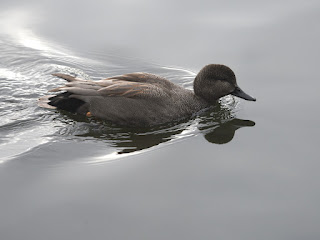The rowan trees on Buck Hill were a hive of activity. Redwings ...
... a Song Thrush ...
... and Blackbirds were eating the fruit ...
... and the resident Mistle Thrush even sang a few phrases.
There were the inevitable Jays expecting to be fed ...
... as well as a hungry Great Tit.
Some Long-Tailed Tits passed through the treetops but I didn't get a good picture, so here is one in the Rose Garden.
A Robin perched on a stem in the Flower Walk.
The male Little Owl called on Buck Hill in the afternoon but I didn't get near enough in time to find him. This is the female.
Three Wood Pigeons ate elderberries in the tree next to the bridge parapet. These heavy birds clinging to thin twigs use their wings to brace themselves.
A Carrion Crow dunked a peanut in a puddle.
A Black-Headed Gull in full breeding plumage stepped out daintily.
The Great Crested Grebe pair near the bridge could be seen from above through the willow twigs. They are defending this area for nesting but haven't actually made a nest yet, and may not until their usual breeding time in the summer.
The dominant Mute Swan at the east end of the Serpentine was being his usual violent self.
A pair of Shovellers revolved at high speed next to a boat. Just looking at them makes you feel dizzy.
A Gadwall drake was in a hurry to rejoin his companions.
Some Buff-Tailed Bumblebees survive the winter if there are flowers for them. Thanks to Abigail for this video from her garden.














Very happy to see there are flying teddybears alive and well even in the heart of winter.
ReplyDeleteI wonder if birds also like the brilliant red colour of the berries. They seem to flock to them.
Plants have evolved so that their ripe edible fruits are red, which does indeed attract birds. The seeds pass through the birds' hasty digestive system undamaged and are deposited in distant places to germinate.
DeleteMammals' more thorough digestion is more likely to kill the seeds. Most mammals can't see red, so they are not attracted to the fruits. (Primates like us, and fruit bats, do have red receptors in their eyes, but these are exceptions.)
A lovely variety of thrushes there. Our local Redwings seem to have temporarily disappeared. I haven't heard Mistle Thrush singing yet (usually the first one) but plenty of song Thrushes singing on local walks.
ReplyDeleteNice to see the Buff-tailed Bumblebee on the Christmas Rose- these & other hellebores are very popular in the winter/early spring for pollinators.
Today the Mistle Thrush was singing quite a lot.
DeleteSomeone on my YouTube channel asked about keeping Buff-Tailed Bumblebees going through the winter. There are sites listing plants they like, but few that flower in winter. I did mention hellebores.